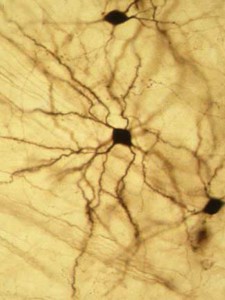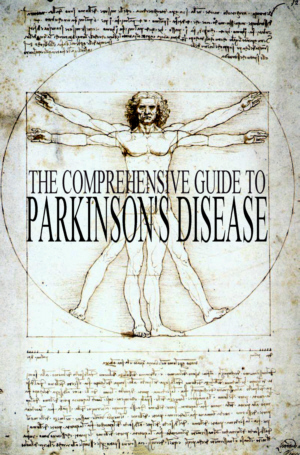|
�
�
�
� � |
Parkinson's Disease News covers
all significant new research, reports, books, and resources concerning
Parkinson's Disease.
Articles are chosen on the basis
of their medical significance or potential interest. Our overwhelming priority
is the facts, regardless of whether they contradict prevailing views or vested
interests. Analysis and further information are provided
either to explain the background or implications, or to
balance misleading claims. If you notice errors or inadequacies, or dispute what is
written, or want to propose articles, please
e-mail
[email protected].
 ��� � ��� �
 ����� �����
 �� �� �� ��
 ���� ����
 ��� � ��� �
 ���� ����
 ���� ����
 ���� ����

�
12th April - New research
DOPAMINERGIC NEURONS MADE FROM ASTROCYTES
|
�CLICK HERE
FOR A
PRINTABLE OR WHITE BACKGROUND VERSION OF THIS ARTICLE |
Dopaminergic
neurons, the cells involved in Parkinson's Disease, have been directly converted from
astrocytes, which are a completely different type of cell.
�The source of the cells were humans, and mice who did not have Parkinson's Disease.
This is different from previous methods, which have aimed at transplanting
the cells affected by the pathological process. The aim of the treatment is
to eventually treat Parkinson's Disease.
 The
theory behind trying to replace the dopaminergic neurons in Parkinson's
Disease is the assumption that there is a massive loss of the cells involved
in Parkinson's Disease, and that the cells therefore need replacing.
However, although it is widely believed that there is massive cell loss in
Parkinson's Disease not a single study has ever shown this to be true. The
study from which these claims originate showed that
there was a major reduction in the activity of the cells involved in
Parkinson's Disease, not a major loss of those cells. Consequently, any
method aimed at replacing dopaminergic neurons does not have a sound scientific basis, and
so would inevitably fail as have all attempts at ridding Parkinson's
Disease by replacing dopaminergic neurons.
For more news go to
Parkinson's Disease News The
theory behind trying to replace the dopaminergic neurons in Parkinson's
Disease is the assumption that there is a massive loss of the cells involved
in Parkinson's Disease, and that the cells therefore need replacing.
However, although it is widely believed that there is massive cell loss in
Parkinson's Disease not a single study has ever shown this to be true. The
study from which these claims originate showed that
there was a major reduction in the activity of the cells involved in
Parkinson's Disease, not a major loss of those cells. Consequently, any
method aimed at replacing dopaminergic neurons does not have a sound scientific basis, and
so would inevitably fail as have all attempts at ridding Parkinson's
Disease by replacing dopaminergic neurons.
For more news go to
Parkinson's Disease News
Reference : Nature Biotechnology [2017] Apr 10
[Epub ahead of print] (P.R.di Val Cervo, R.A.Romanov, G.Spigolon, D.Masini,
E.Mart�n-Monta�ez, E.M.Toledo, G.La Manno, M.Feyder, C.Pifl, Y.H.Ng,
S.P.S�nchez, S.Linnarsson, M.Wernig, T.Harkany,G.Fisone,
E.Arenas)
Complete abstract
 E-MAIL NOTIFICATION : If you would like to be
notified by e-mail when any new articles
are added to Parkinson's Disease News,� please merely
e-mail
[email protected] with the message
"subscribe".� No form of identity is required.� E-mail addresses are
not used for any other purpose. E-MAIL NOTIFICATION : If you would like to be
notified by e-mail when any new articles
are added to Parkinson's Disease News,� please merely
e-mail
[email protected] with the message
"subscribe".� No form of identity is required.� E-mail addresses are
not used for any other purpose.
|
|
|
|
�
 |
THE
COMPREHENSIVE GUIDE TO PARKINSON'S DISEASE
The Comprehensive Guide to Parkinson's
Disease, which is fully referenced, and over 800 pages long, is
the most comprehensive book concerning Parkinson's Disease. It includes the history of Parkinson 's Disease, famous
people with Parkinson's Disease, the complete biochemisty of
Parkinson's Disease,
its cytology and cytological effects,
anatomy and anatomical effects, physiology and physiological
effects, symptoms of every system in the body, the diagnosis methods
(observational, technological, chemical), biochemical causes, all the toxic causes, all the genetic causes, all the
pharmacological causes, all the medical disorders that cause Parkinson's Disease
symptoms, its treatments (biochemical, pharmacological,
surgical, natural, exercise methods, technological methods),
including all those treatments that exist and all those treatments
presently being developed, Parkinson's Disease organisations,
Parkinson's Disease web sites, and books on Parkinson's Disease
nursing.
CLICK HERE FOR MORE DETAILS |
�
|

|
� �
�
�
�
�
�
�
�
�
�
�
�
�
� |
.gif)
.gif)
 ��� �
��� �
 �����
�����
 �� ��
�� ��
 ����
����
 ��� �
��� �
 ����
����
 ����
����
 ����
����




